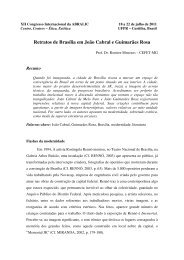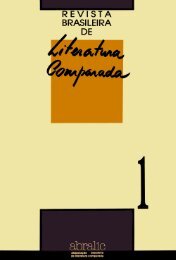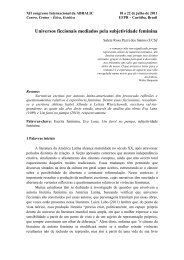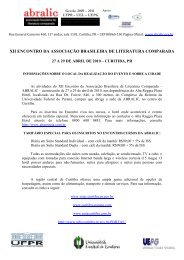download da revista completa (pdf - 9.225 Kb) - Abralic
download da revista completa (pdf - 9.225 Kb) - Abralic
download da revista completa (pdf - 9.225 Kb) - Abralic
You also want an ePaper? Increase the reach of your titles
YUMPU automatically turns print PDFs into web optimized ePapers that Google loves.
20 Revista Brasileira de Literatura Compara<strong>da</strong>, n° 3<br />
other results of Iiterary theory to Ancient Egyptian culture. Let us discuss one<br />
more example. Together, literary and theological texts constitute "the<br />
majority of our evidence" for the existence of myths during the Middle<br />
Kingdom. This precisely explains the impression that aesthetic functions and<br />
functions of magic were often intertwined, and that, although any kind of<br />
magic implies strong claims of referentiality, fictional texts could be used in<br />
contexts of magic practice. In the case of this interesting discursive configuration,<br />
too strong an emphasis on the "literariness" of certain texts and,<br />
as its consequence, an isolation of these "literary" texts from the rest of the<br />
Egyptian corpus could imply the risk of missing - or even of losing - insights<br />
into those phenomena of cultural alterity by which the neighboring disciplines<br />
of Egyptology and the non-academic readership are so particularly<br />
fascinated. Conversely, a not sufficiently skeptical application of the concept<br />
of literature may also run the risk of producing effects of homogenization and<br />
impressions of homogeneity that are as problematic as the effects of isolating<br />
literature from its discursive environment. Therefore, Egyptologists who seek<br />
a dialogue with the most recent debates in literary studies should pay specific<br />
attention to its present tendency of developing distinctions between different<br />
leveIs of mediality, to a tendency, that is, which has opened up new perspectives<br />
of internaI differentiation and historization within the field of western<br />
literatures. 1l For it is Iikely that the application of this aspect to Ancient<br />
Egyptian culture could, in turn, generate insights of paradigmatic value for<br />
Iiterary studies. The functional differentiation between different writing systems<br />
in Ancient Egypt, for example, appears to be more complex and, at the<br />
same time, more systematized than in any of the western Iiteratures. In<br />
contrast, analyses about the degrees of "poeticity" represented by certain<br />
Egyptian texts or investigations regarding their status as "artworks", as impressive<br />
as their argumentations may sometimes look, will always be accompanied<br />
by doubts about their historical and cultural appropriateness.<br />
At the end, an outsider cannot quite repress the question what is at stake<br />
in the Egyptologists' contemporary fascination with a concept of literature<br />
adopted from literary theory - if so much seems to be at risk. Doubtlessly,<br />
this fascination must be motivated and guided by some intuitions which the<br />
outsider, for a sheer lack of reading competence, is not capable of sharing. In<br />
the interest of a fruitful intellectual exchange between the disciplines, it<br />
would certainly be helpful to make more explicit these intuitions which have<br />
led to the be\ief that \iterature, in the western sense of the word, was a part of<br />
Ancient Egyptian culture. But is it too simplistic to go one step further and<br />
ask whether, in addition, the concern 01' a small group of specialists not to lose<br />
the contact with the ongoing debates in the neighboring disciplines may have<br />
played a role in Egyptology's shift to "literariness"? On the one hand, it can<br />
only be in the interest of the scholars of modern Iiteratures that Egyptologists<br />
11 See, as evidence for this<br />
concern. a number of the contributions<br />
to GUMBRECHT,<br />
Hans Ulrich / PFEIFFER, K.<br />
Ludwig, eds.: Materialities of<br />
Communication. Stanford,<br />
1994.




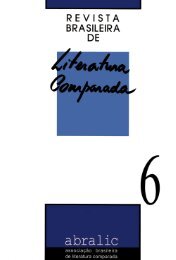
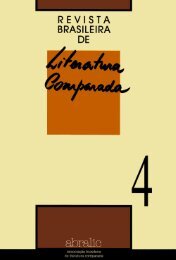
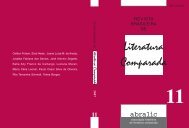
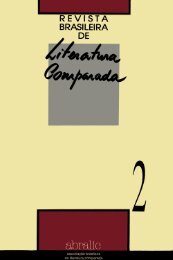
![Olhar Viajante, de Maria Lúcia Medeiros: [homo]erotismo ... - Abralic](https://img.yumpu.com/38407389/1/184x260/olhar-viajante-de-maria-lacia-medeiros-homoerotismo-abralic.jpg?quality=85)
